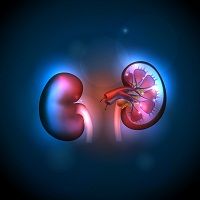Multifactorial Approach Needed to Reduce Residual Risk in Chronic Kidney Disease
Despite achieving optimal goals for "bad" cholesterol levels, individuals with diabetes and chronic kidney disease still have an elevated risk of vascular complications.

Despite achieving optimal goals for “bad” cholesterol levels, individuals with diabetes and chronic kidney disease (CKD) still have an elevated risk of vascular complications. Christoph Wanner, MD, Professor of Medicine and Chief of Nephrology at the University Hospital of Würzburg, Germany spoke regarding efforts to reduce residual risk in this population at Kidney Week in Philadelphia on November 13, 2014.
The Residual Risk Reduction initiative (R3i) is a worldwide academic multidisciplinary research driven nonprofit. Wanner, an R3i steering committee member, related that the importance of residual risk reduction for individuals with type 2 diabetes mellitus (T2DM) and CKD has been made clear by the SHARP (Study of Heart and Renal Protection) and 4D (Die Deutsche Diabetes Dialyse Studie) studies, which examined methods to reduce risk for vascular damage in this population.
In these individuals, although low-density lipoprotein cholesterol (LDL-C) levels may not be high, triglycerides (TGs) are typically elevated, and high-density lipoprotein cholesterol (HDL-C) may be low. Examination of lipid particle types reveals that CKD patients accumulate TG-rich, Apo-B containing particles. This dyslipidemia profile is highly atherogenic. Statins can reduce relative cardiovascular risk by about 23%, primarily through LDL-C reduction, but still leave an unaddressed 77% risk after statin therapy. The addition of ezetimibe can confer a small amount of additional protection, but the residual risk is still significant.
Thus, multifactorial, intensive therapies are still not sufficient to prevent the micro- and macro-vascular disease seen in up to 50% of patients with T2DM. This risk — of such complications as nephropathy, neuropathy, and retinopathy -- persists despite blood pressure and blood glucose control and maintaining intensive LDL-C control.
Atherogenic dyslipidemia, Wanner says, is largely underdiagnosed and undertreated in clinical practice. Kidney patients have high triglycerides, and often also have elevated apo-B and non-HDL cholesterol; is this lipid profile a key contributing factor to the residual vascular risk? Previous work has found that elevated triglyceride levels and triglyceride-rich very low-density lipoproteins (VLDL) were found to be strongly associated with the progression of albuminuria.
R3i’s large REALIST study examined residual risk in CKD patients. Reviewing retrospective data from epidemiologic studies from 40 centers worldwide, REALIST structured a case control study of individuals greater than 40 years of age with T2DM and LDL-C less than 3.4 mmol/L (about 130 mg/dL). Case subjects, who had more than one recorded visit for ocular or renal microvascular complication, were matched with controls, who had T2DM but no microvascular kidney or eye disease. The mostly male subjects, mean age 65, had a mean 14 years since T2DM diagnosis.
Analysis showed a global 1.2 odds ratio for higher rate of kidney disease with higher triglyceride levels. A lower HDL level was also associated with more advanced kidney disease. To further validate this association, patients were stratified by quintiles of TG and HDL-C levels. The quintile with the highest TG levels, and that with the lowest HDL-C levels, had the highest risk of microvascular complications; with risk decreasing by quintile as TG level dropped and HDL-C increased.
REALIST, says Wanner confirms that diabetic kidney disease is associated worldwide with higher levels of plasma TG and lower levels of HDL-C in patients with good LDL-C control. Thus, statin treatment does not eliminate the total cardiovascular risk associated with low HDL-C levels and high TG levels.
R3i thus recommends multifactorial intervention with a combination of therapies to address blood pressure, glycemic control, and lifestyle interventions. Fenofibrates have been shown to help preserve renal function in T2DM; however, recent KDIGO (Kidney Disease Improving Global Outcomes) guidelines recommend extreme caution with fenofibrate treatment for chronic kidney disease, especially in those with estimated glomerular filtration rates (eGFRs) less than 30 mL/min. KDIGO guidelines also say that fenofibrates should not be used in combination with statins for anyone with CKD. “We have to very cautious, very conservative with this population,” said Wanner.
However, there is investigation of such novel targets in cholesterol homeostasis as PCSK9, a natural inhibitor of the LDL-C receptor that maybe be responsible for some residual risk. PCSk9 inhibition may also have pleiotropic effects to address the atherogenic lipid profile seen in CKD. Recommending further study, Wanner said, “We are very early…there are only hypotheses and associations from small trials. We need a proper clinical trial to test all these hypotheses.”